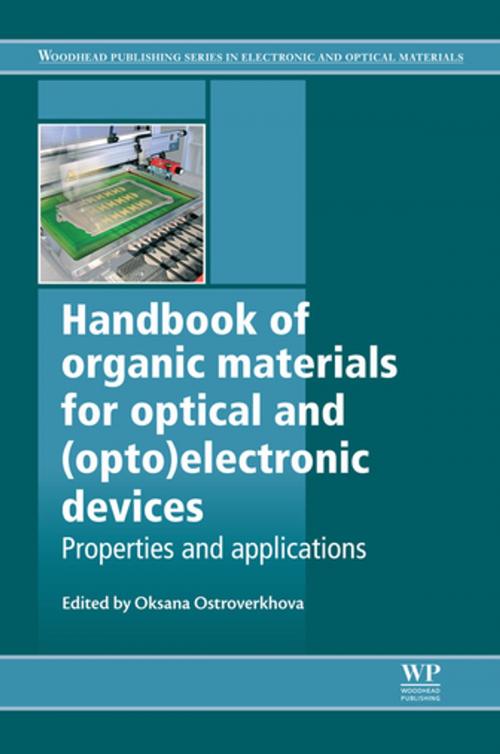Handbook of Organic Materials for Optical and (Opto)Electronic Devices
Properties and Applications
Nonfiction, Science & Nature, Science, Chemistry, Physical & Theoretical, Technology, Electronics| Author: | ISBN: | 9780857098764 | |
| Publisher: | Elsevier Science | Publication: | August 31, 2013 |
| Imprint: | Woodhead Publishing | Language: | English |
| Author: | |
| ISBN: | 9780857098764 |
| Publisher: | Elsevier Science |
| Publication: | August 31, 2013 |
| Imprint: | Woodhead Publishing |
| Language: | English |
Small molecules and conjugated polymers, the two main types of organic materials used for optoelectronic and photonic devices, can be used in a number of applications including organic light-emitting diodes, photovoltaic devices, photorefractive devices and waveguides. Organic materials are attractive due to their low cost, the possibility of their deposition from solution onto large-area substrates, and the ability to tailor their properties. The Handbook of organic materials for optical and (opto)electronic devices provides an overview of the properties of organic optoelectronic and nonlinear optical materials, and explains how these materials can be used across a range of applications.
Parts one and two explore the materials used for organic optoelectronics and nonlinear optics, their properties, and methods of their characterization illustrated by physical studies. Part three moves on to discuss the applications of optoelectronic and nonlinear optical organic materials in devices and includes chapters on organic solar cells, electronic memory devices, and electronic chemical sensors, electro-optic devices.
The Handbook of organic materials for optical and (opto)electronic devices is a technical resource for physicists, chemists, electrical engineers and materials scientists involved in research and development of organic semiconductor and nonlinear optical materials and devices.
- Comprehensively examines the properties of organic optoelectronic and nonlinear optical materials
- Discusses their applications in different devices including solar cells, LEDs and electronic memory devices
- An essential technical resource for physicists, chemists, electrical engineers and materials scientists
Small molecules and conjugated polymers, the two main types of organic materials used for optoelectronic and photonic devices, can be used in a number of applications including organic light-emitting diodes, photovoltaic devices, photorefractive devices and waveguides. Organic materials are attractive due to their low cost, the possibility of their deposition from solution onto large-area substrates, and the ability to tailor their properties. The Handbook of organic materials for optical and (opto)electronic devices provides an overview of the properties of organic optoelectronic and nonlinear optical materials, and explains how these materials can be used across a range of applications.
Parts one and two explore the materials used for organic optoelectronics and nonlinear optics, their properties, and methods of their characterization illustrated by physical studies. Part three moves on to discuss the applications of optoelectronic and nonlinear optical organic materials in devices and includes chapters on organic solar cells, electronic memory devices, and electronic chemical sensors, electro-optic devices.
The Handbook of organic materials for optical and (opto)electronic devices is a technical resource for physicists, chemists, electrical engineers and materials scientists involved in research and development of organic semiconductor and nonlinear optical materials and devices.
- Comprehensively examines the properties of organic optoelectronic and nonlinear optical materials
- Discusses their applications in different devices including solar cells, LEDs and electronic memory devices
- An essential technical resource for physicists, chemists, electrical engineers and materials scientists















